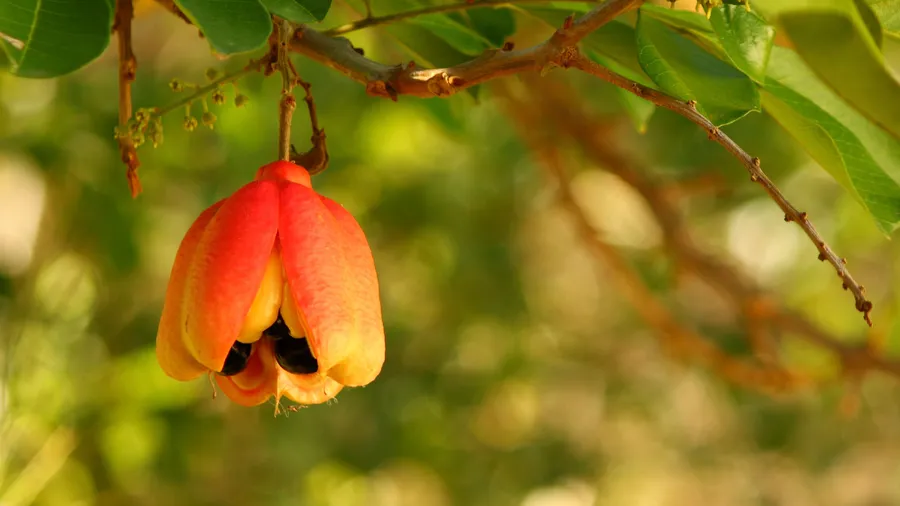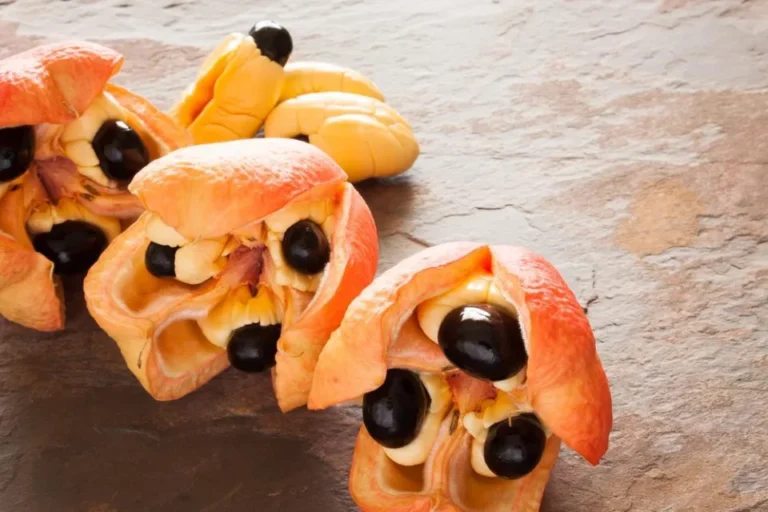The History of Ackee
Ackee, a fruit with a rich history and distinctive appearance, is not only a culinary staple but also an emblem of cultural identity for Jamaica.
This vibrant fruit, scientifically known as Blighia sapida, is recognized for its bright red exterior when ripe, which opens to reveal creamy, pale lobes and shiny black seeds.
While ackee is most famously known as a key ingredient in the national dish of Jamaica—Ackee and Saltfish—its journey from the forests of West Africa to the heart of Jamaican cuisine is a tale of migration, adaptation, and integration.
Originally native to the tropical climates of West Africa, ackee was transported to the Caribbean in the 18th century, where it found a new home in Jamaica.
The exact details of how ackee arrived in Jamaica blend historical records with oral traditions, attributing its introduction to the ships of the transatlantic slave trade and perhaps even to Captain William Bligh, who is often credited with its broader cultivation.
Today, ackee holds a place of honor as Jamaica’s national fruit and remains a cornerstone of its culinary scene.
Its story reflects themes of survival, cultural exchange, and the blending of culinary traditions across continents.
This article will explore ackee’s fascinating journey from its West African roots to its revered status in Jamaica, showcasing how a single fruit can encapsulate the dynamic interplay of history and cultural identity.
Ackee’s Origins and African Roots
Origins in West Africa
Ackee is deeply ingrained in the rich soils and cultural fabric of West Africa, particularly in countries like Ghana, where it is only native but also holds significant cultural importance.
In its native environment, the ackee tree thrives in the humid, tropical climates, often growing wild in forests and also cultivated in yards and village surroundings.
The fruit is less known for culinary uses in Africa compared to its status in the Caribbean but holds medicinal and ritual significance.
Traditional uses include using parts of the tree for medicinal purposes, such as the bark, which is utilized in folk medicine for various ailments.
Botanical Characteristics
The ackee tree, scientifically classified as Blighia sapida, is a member of the Sapindaceae (soapberry) family, which also includes well-known fruits like lychee and longan.
This evergreen tree can grow up to 25 meters tall and is adorned with compound leaves and fragrant white flowers.
The fruit itself is characterized by its unique appearance when ripe: it turns from green to a bright red and splits open to reveal three large, shiny black seeds and bright yellow to cream-colored arils (edible portions), which are the only parts of the fruit that are safe to consume when properly ripe and prepared.

Etymology
The name “ackee” is derived from the Akan language spoken in Ghana, where the fruit is known as “Akye Fufo.”
This term reflects the cultural lineage and linguistic heritage that traveled with the fruit across the Atlantic during the transatlantic slave trade.
The etymological roots of “ackee” highlight the deep historical connections between the peoples of West Africa and the Caribbean, illustrating a poignant aspect of the cultural exchanges that have shaped the Americas.
This name not only traces the fruit’s geographic and cultural journey but also emphasizes the enduring links between these diverse regions.
Transportation to the Caribbean
Historical Journey
The transportation of ackee from West Africa to the Caribbean is a story intertwined with the era of exploration and colonial expansion.
While there is some debate about the exact timeline and method of ackee’s arrival in the Caribbean, it is generally accepted that the fruit came from its native West Africa, possibly brought over with enslaved Africans during the transatlantic slave trade.
Ackee was already well-established in Jamaica and other Caribbean islands by the late 18th century.
It is documented that in 1793, Captain William Bligh transported ackee from Jamaica to the Royal Botanic Gardens in England, where it was further studied and classified.
This facilitated a greater understanding and appreciation of the fruit in botanical and scientific communities.
Ackee’s journey reflects the massive, often forced migrations of people and the natural exchange of goods and agricultural practices that accompanied these movements.
Role of the Slave Trade
Ackee’s spread to the New World was likely significantly influenced by the transatlantic slave trade.
During the 17th and 18th centuries, ships traveling from West Africa to the Americas frequently carried plants and seeds intended for food and trade, and ackee was likely among these.
Thus, the presence of the fruit in the Caribbean can be seen as a direct result of the movements of enslaved Africans, who brought with them not only their strength and resilience but also elements of their agriculture and culture.
Ackee in Jamaica
Early Adoption and Cultivation
Upon its arrival in Jamaica, ackee was initially met with curiosity and cautious interest.
The tropical climate of Jamaica was well-suited for the growth of ackee trees, which flourished alongside other native and imported plants.
Early adoption by local farmers and households saw ackee being cultivated primarily for personal use and local trade.
The tree’s ability to grow without intensive care made it a practical choice for many, and it quickly became a common sight in rural and urban areas alike.
Jamaica is the only place where ackee is widely eaten.
Although introduced to other Caribbean islands, Central America, and Florida, it is not widely consumed or economically significant in these regions.
Integration into Local Cuisine
The real culinary journey of ackee began as it was incorporated into local dishes, blending seamlessly with the ingredients and flavors already established in Jamaican cuisine.
Its mild, slightly nutty flavor made it a versatile companion to a variety of foods.
The pivotal moment came with its pairing with saltfish (salted cod), a combination that would come to be celebrated as Jamaica’s national dish.
This dish, ackee and saltfish, encapsulates the melding of influences that characterize much of Caribbean cuisine, combining the imported saltfish, a remnant of colonial trade practices, with the locally grown ackee to create a dish that is uniquely Jamaican.
Cultural Significance
Over time, ackee’s role in Jamaican culture deepened, moving beyond the kitchen.
It became a symbol of Jamaican identity and culinary tradition, reflecting the island’s history of adaptation and cultural synthesis.
In 1962, in line with Jamaica’s independence, ackee was officially declared the national fruit, cementing its status as an emblem of national pride.
Today, ackee is not only a key ingredient in Jamaican cuisine but also a cultural icon, celebrated in festivals, depicted in art and literature, and recognized globally as a distinctive element of Jamaica’s culinary heritage.
The Expansion of Ackee Globally
Migration of Jamaicans
The global spread of ackee closely parallels the movement of Jamaican people, who, over decades, migrated to places like the United States, Canada, and the United Kingdom.
As Jamaicans established new communities in these regions, they brought with them their traditions and tastes, including a fondness for ackee.
This migration helped introduce ackee to a broader audience, fostering a niche but growing appreciation for Jamaican cuisine around the world.
Specialty grocery stores and Caribbean markets in these diaspora communities often feature ackee, catering to the tastes of Jamaicans abroad while also piquing the curiosity of locals unfamiliar with the fruit.
Global Culinary Influence
Outside of Jamaica, ackee has found a place in various international cuisines, adapting to local tastes and ingredients.
In the United States, for instance, ackee is often used as a substitute in dishes that typically involve scrambled eggs, appealing particularly to vegan and vegetarian consumers seeking novel and exotic flavors.
In the UK, where Caribbean influences are more pronounced due to a larger Jamaican population, ackee is featured in Caribbean-themed restaurants and food festivals, often as part of traditional dishes like ackee and saltfish.
Innovative chefs and culinary enthusiasts around the globe are also exploring the use of ackee in fusion cuisine.
For example, ackee has been incorporated into Spanish tapas and Italian pastas, where its subtle, buttery flavor complements a variety of other ingredients.
Such culinary experiments not only extend the reach and reputation of ackee but also reflect the dynamic nature of global food culture, where traditional boundaries of national cuisines are continuously blending and evolving.
The expansion of ackee’s popularity globally is not just a testament to the mobility of Jamaican people but also an example of how food can serve as a bridge between diverse cultures, facilitating new experiences and exchanges that enrich the global culinary landscape.
Conclusion
The history of ackee from the lush forests of West Africa to the vibrant markets of Jamaica is a vivid narrative of cultural survival and adaptation.
As we trace ackee’s path across oceans and centuries, it becomes evident that this fruit is much more than a dietary staple—it represents a deeper story of cultural resilience and the blending of traditions.
It embodies the spirit of the people who have cultivated and cherished it, thriving in new soils.
Ackee’s integration into Jamaican cuisine, particularly in the iconic dish of ackee and saltfish, delights the palate and connects Jamaica’s present with its past.
This dish, like the fruit itself, shows how diverse elements—from culinary ingredients to cultural traditions—can merge to create something uniquely enriching.
Reflecting on ackee’s broader significance, it becomes clear that this fruit does more than connect Jamaican culture with its African roots; it also bridges diverse cuisines and communities, illustrating how food can transcend geographical and cultural boundaries.
Ackee’s journey from Africa to the Caribbean, highlighting its role in culinary and cultural practices, shows how intertwined our global histories are.
This narrative reveals how the movement of plants and people can enrich societies, creating new identities and enduring traditions.
In celebrating ackee, we celebrate a story of connection and continuity, a testament to the enduring linkages that food can forge across different cultures and historical periods.




